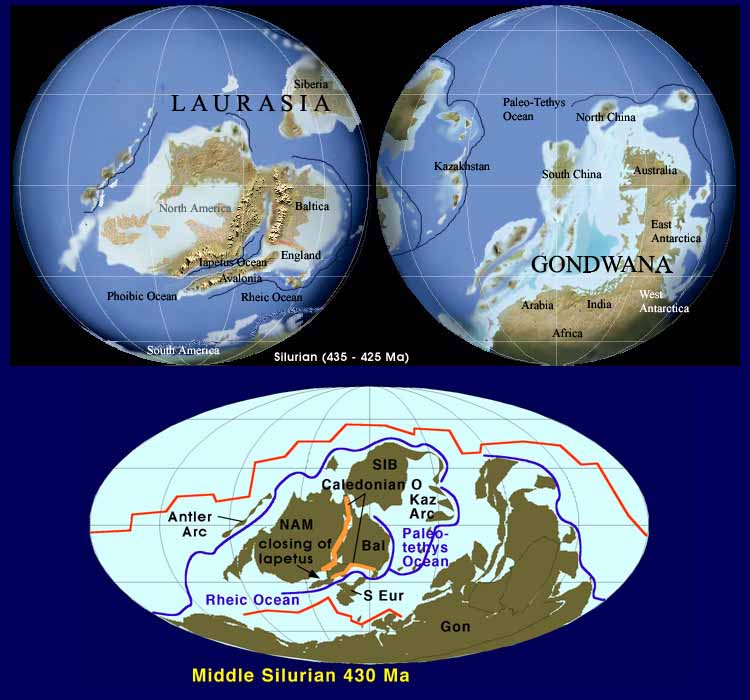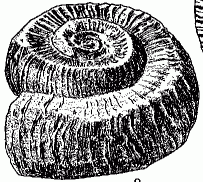
| Palaeos: Paleozoic |  |
Ludlow Epoch |
| Silurian Period | Ludlow |
| Page Back | Back: Wenlock | Back: Ordovician | Up: Silurian | Unit Home |
| Page Next | Next: Pridoli | Next: Devonian | Down: Gorstian | Timescale |

The Silurian World, adapted from the ![]() Paleogeographic
Globes of Prof. Ron Blakey
of Northern Arizona University
Paleogeographic
Globes of Prof. Ron Blakey
of Northern Arizona University
The geography of the Ludlovian world is best known for the on-going train wreck which began the assembly of Laurasia -- or actually "Laurasia I" since there are arguably two continents by that name. By Ludlovian times, Baltica (including Scandinavia, European Russia and parts of Northern Europe) had collided with Laurentia (North America and Greenland). This began the north to south closure of the Iapetus Ocean which had previously separated the two. The western edge of Baltica was subducted under the Laurentian continent, with drastic effects in North America. These effects included the northern part of the Acadian Orogeny, a string of new volcanoes stretching from East Greenland (future home of Ichthyostega and other famous fossils) down the Laurentian coast towards New York and Pennsylvania.
In the meanwhile, the microcontinent of Avalonia, as well as bits and pieces of Southern Europe which had been flaking off the Gondwanan landmass, were running full tilt into the southern shores of Laurentia and Baltica. These fragments would add to what is now the lower eastern seaboard of the United States and Southern Europe, respectively. The exact timing of these events is not clear. Current thinking is that at least some of the European pieces arrived in Ludlovian times, but that Avalonia did not close the southern part of the Iapetus before the Pridoli, at the earliest.
Still further behind, Siberia was approaching the new Laurasian landmass from the northeast, followed by parts of what would eventually become Kazakhstan and Central Asia. The rest of the world looked much as it had since the beginning of the Cambrian, except that the entire Gondwanan landmass was continuing its slow slide across the South Pole which, in this era, passed through south central Africa. ATW
The Ludlow was a moderately warm era. The Ice Age which ended the Ordovician had long been over, although a small polar ice cap was probably still present in Africa. Oxygen had reached 50-100% of modern levels in the atmosphere, favoring the evolution of larger animals in suitable, shallow-water environments. There were a good many of these, since the Ludlow experienced the highest sea levels of the Paleozoic, and shallow seas covered many continental areas. Carbon dioxide levels were still quite high, perhaps 10 times today's concentrations. Indeed, carbon dioxide may actually have been increasing due to the extensive volcanic activity which accompanied the formation of Laurasia. The enormous Gondwanan peninsula formed by Australia and Antarctica prevented the formation of a continuous current around the South Pole, and the shores of the Gondwanan mainland were warmed by tropical waters flowing southeast through the Rheic Ocean. ATW
The following diagram is a reconstruction of a late Ludlovian Salopina Community from W. S. McKerrow The Ecology of Fossils.

This is a shallow water marine benthic ecosystem that lived by the shore of the disappearing Iapetus Sea, Avalonia (see map, above, for global geography). Today this is the Welsh Borderlands. The Salopina Community succeeded the earlier Eocolia Community. The most common organism are suspension-feeding brachiopods and bivalves. Shown here are the brachiopods (e) Ferganella, a Rhynchonellid; (f) Salopina, an Orthid; and (g) Protochonetes, a primitive Productid; and the Bivalvia (c) Pteronitella, a Pterioid, and (h) Palaeoneilo, a nuculoid.
 |
|
image © McGraw Hill Book Company, from Moore, et al. 1952, p.300
|
Protochonetes belongs to the Superfamily Chonetoidea, an ancestral group from which the rest of the Productida clade derived. So this was early and primitive member of a lineage that would become extremely important during the late Paleozoic. Productids are distinguished by the spines that protrude from the shell, anchoring it and allowing it to be raised above the sand and mud. This was an important ecological adaptation, because it reduced the possibility of fouling, and hence gave productids an advantage over other brachiopod groups.
Of other animals in this scene, Crinoids represent a higher tier of filter-feeders. The substrate consists of sand, or more fine-grained mud and silt. This was home to burrowing animals - worms, bivalves, trilobites, and others - as indicated by the bioturbation (disturbed mud). Gastropods are represented by the Euomphalid Poleumita, with a near-planispiral shell. A related species is shown at the right.
The same general area and age also yields a rare Silurian Lagerstätten, as indicated in the following report by Dr David Gladwell of the University of Leicester:
"An exceptionally preserved biota of Upper Silurian (Ludlow Series) age is found in Lower Leintwardine Formation Channel fill deposits around Leintwardine in the Central Welsh Borderland. There are six submarine channels in total, although only four outcrop and yield fossil faunas...The fauna is diverse, containing common representatives of Silurian biotas (such as brachiopods and trilobites), along with more unusual forms such as ophiuroid and asteroid seastars, eurypterids, xiphosurids and phyllocarids....(T)he echinoderms are mostly complete, whilst the majority of the arthropod material is made up of disarticulated components. Specimens are predominately preserved as hard-parts, although occasional soft-body preservation is encountered in the form of rare 'worm' fossils. In addition to the dominant invertebrate fauna, relatively rare disarticulated components of heterostracan fish are found; the sole taxon found, Archaegonaspis ludensis (Salter, 1859) is the earliest known British species..."
Even at this early date, the development of terrestrial ecosystems was well under way, as indicated by the following passage.
"Sherwood-Pike and Gray (1985) describe probable ascomycete [this is unlikely! -- ATW] hyphae from Late Silurian (Ludlow) strata. They suggest that these were terrestrial Fungi at least contemporaneous with the earliest land plants. Some hyphae occurred inside small rounded pellets of apparent invertebrate fecal material; if this is correct, it suggests a fauna that included mycophagous (fungus-eating) microarthropods. Rolfe (1985b) accepts this suggestion and identifies millipedes from Late Silurian (Ludlow-Pridoli), now complemented by the discovery of predatory animals (Jeram et al. 1990). The importance these observations is that they confirm at least a minimal terrestrial food consisting of primary producers, decomposers, secondary consumers, and predators."
MAK
| Page Back | Unit Home | Page Up | Page Top | Page Next |